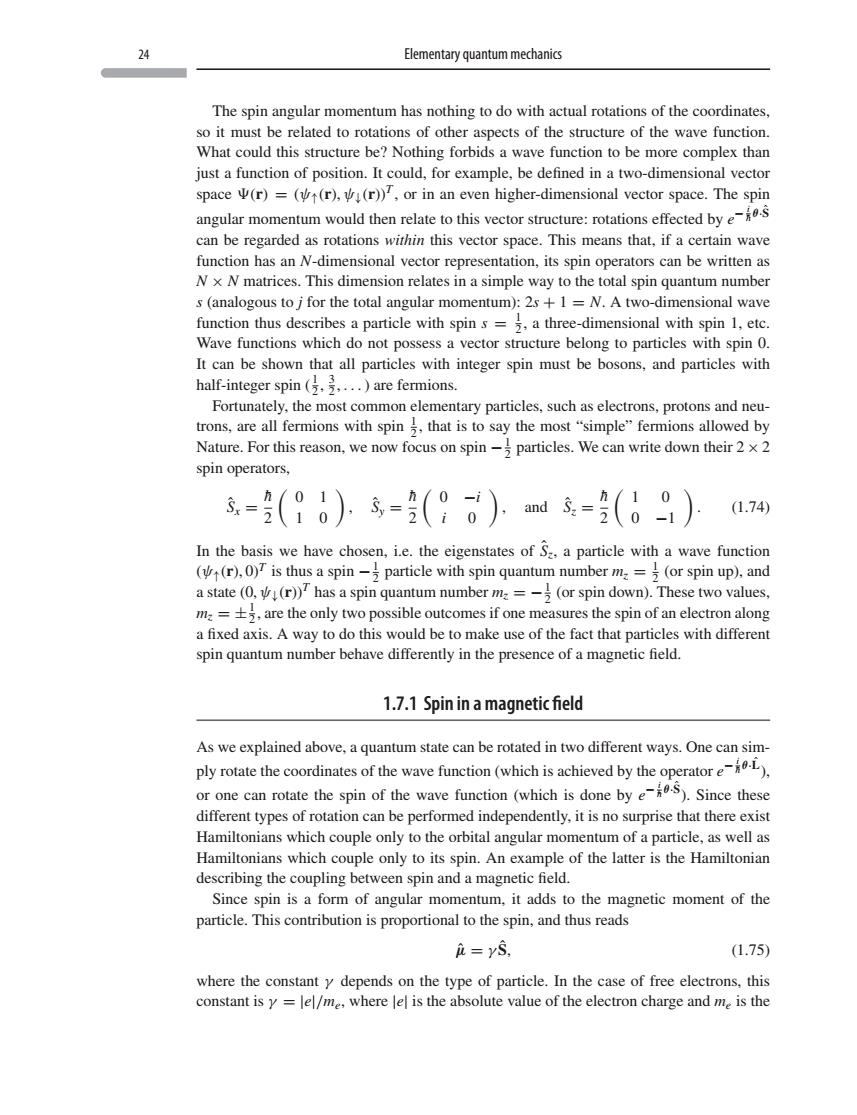正在加载图片...

Elementary quantum mechanics The spin angular momentum has nothing to do with actual rotations of the coordinates be related to rotations of other aspects of the structure of theave What be?Nothing forbids complex thar just a function of position.It could,for example,be defined in a two-dimensional vector space (r)=((r).(r)),or in an even higher-dimensional vector space.The spin angular woud then relate to this:effected by can be regarded as rotations within this vector space.This means that.if a certain wave function has an N-dimensional vector representation,its spin operators can be written as Nx N matrices.This dimension relates in a simple way to the total spin quantum number s(analogous to j for the total angular momentum):2s+1 =N.A two-dimensional wave 6 action thus a particle with spins Wave functions whichdo posse a three-dimensional with s a vector structure ong to particles with spin 0 It can be shown that all particles with integer spin must be bosons,and particles with half-integer spin (....are fermions. Fortunately.the most common elementary particles.such as electrons.protons and neu trons,.are all fermions with spin是,that is to say the most“simple”fermions allowed by We can write down their 2x 2 spin operators. s=(90)$-(9。)m=(09) 1.74) In the basis we have chosen,ie.the eigenstates ofa particle with a wave functior (r.0 is thus a spin-particle with spin quantum number m=(or spin up).and a state (0.(r))has a spin quantum number m:=-(or spin down).These two values m=,are the only two possible outcomes if one measures the spin of an electron along a fixed axis.A way to do this would be to make use of the fact that particles with different spin quantum number behave differently in the presence of a magnetic field. 1.7.1 Spin in a magneticfield As we explained above,a quantum state can be rotated in two different ways.One can sim- different types of rotation can be performed independently.it isno rprise that there xis Hamiltonians which couple only to the orbital angular momentum of a particle.as well as Hamiltonians which couple only to its spin.An example of the latter is the Hamiltonian describing the coupling between spin and a magnetic field. Since spin is a form of angular momentum.it adds to the magnetic moment of the i=ys. (1.75 where the constant y depends on the type of particle.In the case of free electrons.this constant is y=lel/me,where lel is the absolute value of the electron charge and me is the24 Elementary quantum mechanics The spin angular momentum has nothing to do with actual rotations of the coordinates, so it must be related to rotations of other aspects of the structure of the wave function. What could this structure be? Nothing forbids a wave function to be more complex than just a function of position. It could, for example, be defined in a two-dimensional vector space (r) = (ψ↑(r), ψ↓(r))T , or in an even higher-dimensional vector space. The spin angular momentum would then relate to this vector structure: rotations effected by e − i h¯ θ·Sˆ can be regarded as rotations within this vector space. This means that, if a certain wave function has an N-dimensional vector representation, its spin operators can be written as N × N matrices. This dimension relates in a simple way to the total spin quantum number s (analogous to j for the total angular momentum): 2s + 1 = N. A two-dimensional wave function thus describes a particle with spin s = 1 2 , a three-dimensional with spin 1, etc. Wave functions which do not possess a vector structure belong to particles with spin 0. It can be shown that all particles with integer spin must be bosons, and particles with half-integer spin ( 1 2 , 3 2 , ... ) are fermions. Fortunately, the most common elementary particles, such as electrons, protons and neutrons, are all fermions with spin 1 2 , that is to say the most “simple” fermions allowed by Nature. For this reason, we now focus on spin −1 2 particles. We can write down their 2 × 2 spin operators, Sˆx = h¯ 2 0 1 1 0 , Sˆy = h¯ 2 0 −i i 0 , and Sˆz = h¯ 2 1 0 0 −1 . (1.74) In the basis we have chosen, i.e. the eigenstates of Sˆz, a particle with a wave function (ψ↑(r), 0)T is thus a spin −1 2 particle with spin quantum number mz = 1 2 (or spin up), and a state (0, ψ↓(r))T has a spin quantum number mz = −1 2 (or spin down). These two values, mz = ±1 2 , are the only two possible outcomes if one measures the spin of an electron along a fixed axis. A way to do this would be to make use of the fact that particles with different spin quantum number behave differently in the presence of a magnetic field. 1.7.1 Spin in a magnetic field As we explained above, a quantum state can be rotated in two different ways. One can simply rotate the coordinates of the wave function (which is achieved by the operator e − i h¯ θ·Lˆ ), or one can rotate the spin of the wave function (which is done by e − i h¯ θ·Sˆ ). Since these different types of rotation can be performed independently, it is no surprise that there exist Hamiltonians which couple only to the orbital angular momentum of a particle, as well as Hamiltonians which couple only to its spin. An example of the latter is the Hamiltonian describing the coupling between spin and a magnetic field. Since spin is a form of angular momentum, it adds to the magnetic moment of the particle. This contribution is proportional to the spin, and thus reads μˆ = γ Sˆ, (1.75) where the constant γ depends on the type of particle. In the case of free electrons, this constant is γ = |e|/me, where |e| is the absolute value of the electron charge and me is the